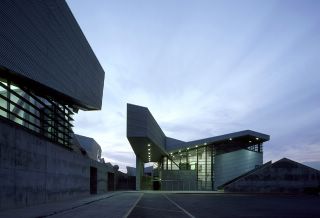Architecture's Bad Boy
Everyone likes bad boys. Good girls, good boys, other bad boys, myself ... and architects.
On Monday the world's top design award-the 2005 Pritzker Architecture Prize-was awarded to LA-based Thom Mayne, a 1960s rebel who has been described as the 'bad boy' of architecture. A generation ago, his bold asymetrical designs were considered blasphemous; today they inspire awe and wonder. His projects often feature cantilevered wings that jut into air, sharp edges and high arching walls. Mayne's work is at peace with nature, exposing open space that is appreciated by winding walkways.
The award is considered the Nobel Prize of architecture, and the Los Angeles architect is the first American in 14 years to win the distinction. Previous recipents include Frank Gehry (who now sits on the award committee), I. M. Pei, Philip Johnson and Richard Meier.
Mayne is a founder of the Los Angeles design firm Morphosis. Over Mayne's three-decade career he has designed projects as far away as Germany, Japan, South Korea, Spain and Taiwan. Mayne's work is non-traditional; expect feature sharp, angular construction, as evident above in 2002's Hypo Alpe Adria Center in Klagenfurt, Austria. The architect's concept was to integrate the exapanding city center with the outlying rural terrain. The bank building fuses function with form, at harmony with surrounding fields and open space.
Mayne says his designs seek to integrate society with its surroundings. To that end, many of his commissions are more than simply buildings: they seek balance and establish beautiful relationships with sky and space. Diamond Ranch High School blurs common distinctions between building and landscape. The stunning campus is in the foothills of the Pomona Valley, and the high school environment mimicks the surroundings. Two rows of fragmented forms are set on either side of a long “canyon” or sidewalk. The "canyon" bisects the hillside much like a geologic fault line.
The Pritzker Architecture Prize was established in 1979 by the Chicago-based family of the same name. They have long been known for their support of educational, social welfare, scientific, medical and cultural activities. Laureates of the Pritzker Architecture Prize receive a $100,000 grant, a formal citation certificate, and since 1987, a bronze medallion.
The Pritzker Architecture Prize: Online Press Kit
Great Buildings Online
Morphosis
Related:
Kahn's National Assembly: brotha2Brotha







